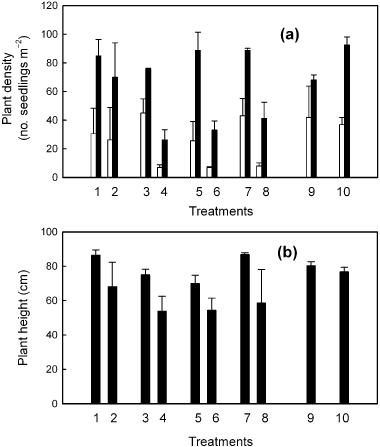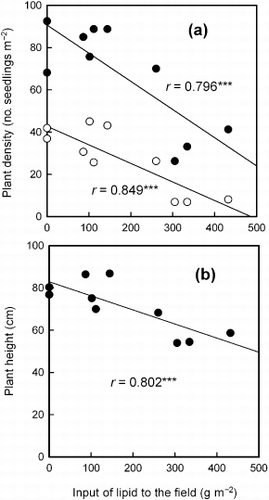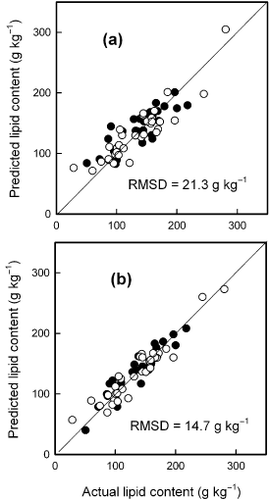Abstract
The purpose of the present study was to evaluate the capability of near infrared spectroscopy (NIRS) as a simple method to monitor the lipid content of garbage compost, which is a potential inhibitor of plant growth. We conducted a cultivation experiment with vegetable mock pak choy (Brassica rapa L. Parachinensis Group) using two application rates of four garbage composts that differed in lipid content. The input of lipid from the compost to the field showed a significant negative correlation with germination rate and plant height in the initial growth stage. Reflectance spectra of untreated and freeze-dried and milled compost samples were taken using a scanning monochromator. Second-derivative spectra and multiple regression analysis were used to develop calibration equations for lipid and moisture contents. The calibration was carried out with the short wavelength region ([SWR] 800–1100 nm) and the long wavelength region ([LWR] 1100–2500 nm) separately. The calibration equations with the LWR were more accurate than those with the SWR for lipid and moisture determinations. The accuracies of the calibration equations for untreated samples were comparable to those for freeze-dried and milled samples. In conclusion, we suggest that the application rate of garbage compost can be determined by measuring the lipid content of untreated samples by NIRS.
INTRODUCTION
The reduction and recycling of food waste, such as dead stock, food leftovers and kitchen refuse, have become important issues in Japan (CitationTakemoto 2006; CitationUshikubo 2003). The annual amount of such food waste that is generated during the manufacture, distribution and consumption is 20 billion tones in Japan, and less than 100 g kg−1 of this waste is recycled (CitationUshikubo 2003). To dispose of food waste sanitarily and efficiently, electric garbage processors have been developed and introduced in various places, such as canteens in factories and schools, supermarkets and restaurants. Part of the treated garbage produced by such devices (referred to as “garbage compost” hereafter) is applied to farmland as organic fertilizer. As a result, the production of compost from food waste and the application of this compost are expected to simultaneously reduce waste and promote sustainable agriculture; however, the application of garbage compost with a high lipid content to farmland is known to inhibit plant growth (CitationTakemoto 2006). Therefore, determination of the lipid content of garbage compost using near infrared spectroscopy (NIRS), which can replace the time-consuming Soxhlet extraction method, was investigated and sufficient accuracy was reported for air-dried and milled samples (CitationFujiwara et al. 2007).
CitationTakemoto (2006) carried out an experiment using potted plants and reported that garbage compost with a high lipid content inhibited the germination and growth of komatsuna (Brassica rapa L. Perviridis Group). The main cause of germination and growth inhibition was the immobilization of nitrogen and the suppression of nitrogen mineralization. CitationTakemoto (2006) also conducted a similar experiment applying chemical fertilizer and edible oil to the potted plants, and showed a negative correlation between the germination rate or the growth of komatsuna and the rate of oil application. To put NIRS to practical use, it is necessary to study the relationship between the lipid content of garbage compost and the inhibition of plant growth more quantitatively in field experiments, and to develop a simpler method to measure the lipid content of untreated compost samples using NIRS. In addition, the moisture content of the garbage compost was determined to evaluate the handling properties of compost and to permit a comparison of lipid contents between wet and dry samples. In the present study, we investigated the effect of applying garbage compost with different lipid contents on the growth of vegetables cultivated in soil and we measured the accuracy of estimating the lipid and moisture contents of untreated compost samples using NIRS.
Table 1 Composting methods, sources and constituents of the garbage compost used
MATERIALS AND METHODS
Garbage compost samples
summarizes the composting methods and sources of the garbage compost samples used in the present study. Samples were obtained from nine places, including canteens in companies, a food production factory, a supermarket and a hospital, in Shiga, Kyoto and Nara prefectures, Japan. Between two and eight compost samples were collected from each place on different days (total samples = 62). The compost samples were produced from food waste, such as cooking refuse and leftovers, using electric garbage processors. Garbage processors are roughly classified into microbial decomposition types and drying types (CitationTakemoto 2002). Three places used the microbial decomposition type and six places used the drying type garbage processor.
Samples were dried using a freeze-dryer (FRD-82M; Iwaki Glass, Tokyo, Japan), milled with a coffee mill (MK-61N; Matsushita Electric Industrial, Kadoma, Japan) and passed through a 1-mm mesh sieve. Untreated samples were subjected to lipid analysis and NIRS. Freeze-dried and milled samples were subjected to NIRS.
Cultivation experiment
The vegetable mock pak choy (“saishin” Brassica rapa L. Parachinensis Group) was cultured in an unheated greenhouse at Higashiohmi farm, Ohmi Tampopo-Mura, Shiga, Japan, to test the effect of compost lipid content on plant growth. The soil was a gray lowland soil and its chemical properties were: pH (H2O) 5.9, electrical conductivity (soil : water = 1:5) 1.47 dS m−1, cation exchange capacity 15.1 cmolc kg−1, Truog-P2O5 1.49 mg g−1, exchangeable K2O 0.83 mg g−1, exchangeable MgO 0.38 mg g−1 and exchangeable CaO 2.95 mg g−1. Four garbage compost samples with different amounts of lipid were used. The design of the experiment for fertilizer application is shown in . Each treatment was carried out in duplicate plots (each plot was 1 m × 3 m). Garbage and poultry manure composts were applied on 8 November 2007 and seeds of mock pak choy were sown using a manual seeder (HS-300E; Mukai, Yao, Japan) on 9 November 2007. Plant density and plant height were measured 8 days and 22 days after sowing.
References analysis
The moisture of the samples was determined by the weight loss during freeze-drying. For lipid content determination, 2 g of each sample was extracted in diethyl ether for 8 h (Soxhlet extraction method; CitationJapan Oil Chemists’ Society 1996). The extract, which corresponds to the total lipids of the sample, was dried and weighed; the lipid content was expressed as a percentage of the sample dry weight.
Table 2 Design of the field experiment
Near infrared spectroscopy and regression analysis
The reflectance spectra of untreated samples and freeze-dried samples were measured using a NIR spectrophotometer (Model 6500; Foss-NIRSystems, Laurel, MD, USA) with a standard sample cup. Data acquisition and analysis were conducted using the Vision software package (ver.3.2, Foss-NIRSystems). The samples were scanned 32 times from 400 to 2500 nm and data were collected every 2 nm.
The data were divided into a calibration set (32 samples) and a prediction set (30 samples). These sample sets were selected so that the distributions of each constituent were similarly spread, and care was taken to ensure that the calibration set did not concentrate around any point in the range. To suppress background signals and to enhance the visual resolution, second-derivative spectra of each sample were used for calibration and prediction. When producing the derivatives, the segment size and gap size were set to 10 and 0 nm, respectively. The calibration equations were developed by multiple linear regression with the second-derivative spectra and the constituents of the calibration set. The accuracy of the calibration equations was determined by the root mean square deviation ([RMSD]CitationHruschaka 1987), the ratio of the standard deviation of the prediction set to the standard error of the prediction ([RPD]CitationWilliams 1987) and the ratio of the range in the prediction set to the standard error of the prediction ([RER]CitationWilliams 1987).
The NIR spectrophotometer has two common detectors, a silicon detector and a lead sulfide detector, that are used for the wavelength regions of 400–1100 nm and 1100–2500 nm, respectively. Considering some spectrophotometers can measure only in one region, the regression analysis was carried out using these two regions (excluding 400–800 nm as a visible region) separately.
RESULTS AND DISCUSSION
Lipid and moisture contents of the samples
As shown in , the lipid content of the samples varied widely with a higher average value than our previous report (75.9 g kg−1, range 2.8–177.0 g kg−1; CitationFujiwara et al. 2007). Although the lipid content of the compost produced by the microbial decomposition processor was generally low, the lipid content of the compost from two places (Food production factory [1] and Factory canteen [1]) was higher than average. The short treatment period of only 1 day probably caused the high lipid content found in the compost from these two locations. As the drying processor does not decompose the lipid in garbage very much, variation in the lipid content among the compost samples produced by this type of processor probably resulted from differences in the lipid content of the food waste.
Effect of lipids in garbage compost on plant growth
shows the plant density and plant height of mock pak choy treated with garbage compost from four different sources with two application rates of each source and of the untreated controls with and without supplemental poultry manure (treatments 9 and 10, respectively). Applications of garbage compost at a rate of 3 kg m−2, except the compost with the lowest lipid content treatment, strongly inhibited germination. Plant height showed a similar level of inhibition; however, 1 kg m−2 compost applications did not inhibit germination and initial growth. Germination rate and plant height showed a significant negative correlation with the input of lipid from compost (). In livestock waste compost, factors other than lipid were reported to inhibit plant growth. CitationFujitani et al. (1995) reported that cattle waste compost with an electrical conductivity > 8 dS m−1 (1:10 water extraction) strongly inhibited germination of Komatsuna. In addition, the application of livestock waste compost with a high C/N ratio is known to cause nitrogen starvation in crop plants as a result of nitrogen immobilization (CitationHarada et al. 1993). In our field experiment, the electrical conductivity values of the compost were not very high () and significant relationships were not observed between the electrical conductivity or C/N ratio and plant density or plant height (; ). Thus, the lipid in the garbage compost was assumed to be one of the causes of plant growth inhibition and a suitable indicator of this inhibition. In many cases, the more compost applied, the stronger the growth inhibition (CitationFujiwara et al. 2004). Therefore, inhibition caused by compost should be evaluated quantitatively. Overall, we suggest that the lipid content of garbage compost should be determined prior to field application to avoid inhibition of plant growth.
Figure 1 Effect of garbage compost application on (a) plant density and (b) plant height of mock pak choy. Measurements were made 8 days (□) and 22 days (▪) after seeding. The treatments are described in Table 2.

Figure 2 Relationship between the input of lipid contained in the garbage compost applied to the field and (a) plant density and (b) plant height of mock pak choy. The investigation was carried out 8 days (○) and 22 days (•) after seeding. The points show data from each treatment in the field experiment.

Table 3 Results of the multiple regression and errors between the predicted and actual lipid content or moisture in the garbage compost as determined by near infrared spectroscopy using second-derivative spectra in the short wavelength region (800–1100 nm)
Table 4 Results of the multiple regression and errors between the predicted and actual lipid content or moisture in the garbage compost as determined by near infrared spectroscopy using second-derivative spectra in the long wavelength region (1100–2500 nm)
Regression analysis
The results of the multiple regression analyses and the predictions derived from the calibration equations are shown in (short wavelength region [SWR]) and (long wavelength region [LWR]). The accuracy of the estimates of the lipid contents in freeze-dried and milled samples by NIRS using LWR was comparable to that reported in a previous paper (RPD = 4.0, RER = 12.4; CitationFujiwara et al. 2007). The key wavelengths for lipid calibration, 1040 nm (C-H stretching and C-H deformation) and 1762 nm (C-H stretching first overtone), were also the approximate wavelengths for peak absorption of fats and lipids (CitationOsborne and Fearn 1986a,Citationb).
The RMSD of lipid and moisture contents with LWR were lower than those with SWR, although the calibration equation for lipid using LWR included one less wavelength than that used for SWR. One reason for this result is the assumption that LWR has higher resolution than SWR; however, even the calibrations using SWR can be used for screening purposes (). Despite our expectations, there were not big differences in the accuracy of the calibration equations for lipids between the samples prepared using the different methods. Thus, easy analysis without drying and milling is applicable.
The calibration equation for moisture showed similar accuracy to the equations for lipid content, in terms of RPD and RER (, ). The key wavelengths for the calibrations for moisture, 974 and 1928 nm, were in the absorption bands of O-H stretching second overtone and a combination of O-H stretching and O-H deformation, respectively (CitationOsborne and Fearn 1986a; CitationWorkman and Weyer 2007).
Figure 3 Values predicted by near infrared spectroscopy using the (a) short wavelength region (SWR) and (b) long wavelength region (LWR) versus the actual values of lipid content in the untreated garbage compost in the calibration (○) and prediction (•) sample sets. The solid line shows y = x. Wavelengths used: (a) 1040, 980, 802, 906 and 1020 nm; (b) 1762, 1802, 2270 and 1632 nm. RMSD, root mean square deviation.

Therefore, NIRS is useful for simultaneously estimating the lipid and water contents of garbage compost samples without any pretreatment. We suggest that the application rate of garbage compost can be based on the lipid content measured using NIRS with untreated compost samples.
ACKNOWLEDGMENTS
The work described in this report was funded by a grant for “Research for Promoting Technological Seeds” from the Japan Science and Technology Agency. The authors thank Dr K. Kagotani and Mr A. Ohmi of Tsuji Oil Mill for their help with the lipid analysis.
REFERENCES
- Fujitani , S , Noji , Y and Yano , T . 1995 . [Quality inspection of livestock waste composts] . Bull. Oita Pref. Agri. Res. Ctr , 25 : 63 – 75 . (in Japanese with English summary)
- Fujiwara , T , Hara , M and Murakami , K . 2004 . Proposal of germination test of animal waste compost that reflects the rate of application and reduces the effect of EC and pH of water extract . Jpn. J. Soil Sci. Plant Nutr , 75 : 241 – 245 . (in Japanese)
- Fujiwara , T , Murakami , K , Takemoto , M and Fujiwara , S . 2007 . Measurement of lipid content of garbage compost using near infrared spectroscopy . Jpn. J. Food Eng , 8 : 21 – 27 .
- Harada , Y , Haga , K , Osada , T and Koshino , M . 1993 . Quality of compost produced from animal wastes . JARQ , 26 : 238 – 246 .
- Hruschka , WR . 1987 . “ Data analysis: wavelength selection method ” . In Near-infrared Technology in the Agricultural and Food Industries , Edited by: Williams , P and Norris , K . 35 – 55 . St Paul : American Association of Cereal Chemists .
- Japan Oil Chemists’ Society . 1996 . Standard Methods for the Analysis of Fats, Oils and Related Materials , Tokyo : Japan Oil Chemists’ Society . (in Japanese)
- Osborne , BG and Fearn , T . 1986a . “ Chemical assignments of near infrared bands. Theory of near infrared spectrophotometry ” . In Near Infrared Spectroscopy in Food Analysis , 28 – 40 . Harlow : Longman Scientific & Technical .
- Osborne , BG and Fearn , T . 1986b . “ Fat. Applications of near infrared spectroscopy in food analysis ” . In Near Infrared Spectroscopy in Food Analysis , 130 – 131 . Harlow : Longman Scientific & Technical .
- Takemoto , M . 2002 . [Characteristics of the end products of an electric garbage processor.] . Jpn. J. Soil Sci. Plant Nutr , 73 : 155 – 159 . (in Japanese)
- Takemoto , M . 2006 . [Studies on the composting of food wastes and the agricultural application.] . Bull. Kanagawa Agri. Tech. Cent , 148 : 1 – 121 . (in Japanese with English summary)
- Ushikubo , A . 2003 . [Food industry and household waste: current situation and future trends.] . Waste Manag. Res , 14 : 216 – 227 . (in Japanese)
- Williams , PC . 1987 . “ Interpretation of statistical evaluation of NIR analysis. Variables affecting near-infrared reflectance spectroscopic analysis ” . In Near-infrared Technology in the Agricultural and Food Industries , Edited by: Williams , P and Norris , K . 146 – 148 . St Paul : American Association of Cereal Chemists .
- Workman , J and Weyer , L . 2007 . “ Spectra-structure correlations for near infrared ” . In Practical Guide to Interpretive Near-Infrared Spectroscopy , 239 – 263 . Boca Raton : CRC Press .